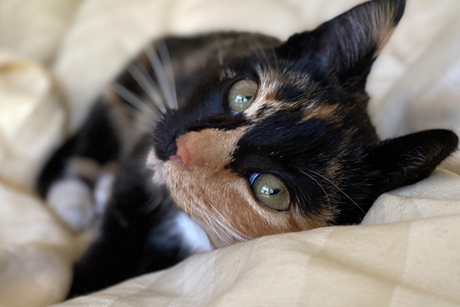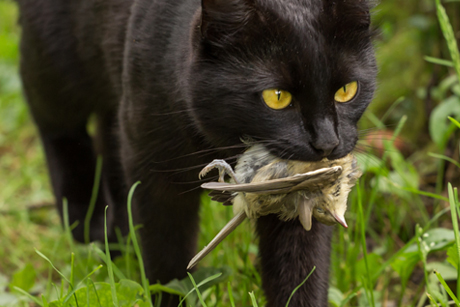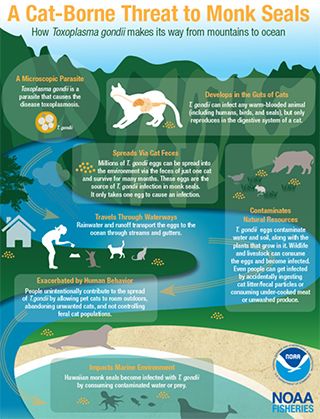Services we offer:
- Catio and Cat Garden design and construction
- Assistance with trapping and transport
- Medical care, spay/neuter liaison
- Humane repellents and deterrents
- Stray cat management consulting
OUR POSITION ON FREE-ROAMING AND FERAL CATS
Cats are domesticated animals, dependent on humans for their well-being. They are warmth-loving companion animals that deserve to be sheltered from the elements, to have clean drinking water, nutritious food, to be groomed and kept free of parasites, to receive vaccinations against diseases and treated for ailments, to be loved and cared for throughout their lives.
Cats deserve our compassion and respect, not to be treated like tools, or numbers in a scheme. Unfortunately, however, there is an ongoing effort to reduce euthanasia rates at animal shelters by dumping cats on the streets or pimping them as 'working cats' for rodent control.
A quote from PETA on the practice:
If your local shelter is considering adopting a policy of refusing to admit cats or abandoning them outdoors in order to avoid including them on their annual intake and outcome statistics, remind shelter officials that their top priority should be animal welfare and safety—not deceptive, feel-good statistics. (more)
It's mind-boggling how animal rescue organizations and tax-funded programs that are supposed to fight animal cruelty and alleviate suffering are exploiting poor cats for their own gain without any regard for the devastating consequences - the impacts the cats will have on the area's wildlife, the environment, public health, and the rights of property owners. It is simply cruel, unethical and unacceptable.
If your shelter is refusing to take cats or other animals, click HERE.
The answer to managing unowned free-roaming cats is TENVAC - Trap, Evaluate, Neuter, Vaccinate, Adopt, Contain. The comprehensive plan, introduced by the Hillsborough Animal Foundation, is based on the American Veterinary Medical Association's feral cat policy which considers all priorities including public health, wildlife, and the welfare of cats. See the proposal as it was submitted in 2013, HERE.
We support responsible pet ownership which includes licensing and mandatory containment of cats - no free-roaming.
THE PROBLEM WITH FREE-ROAMING CATS
HEALTH RISKS TO HUMANS
Felines are the sole definitive host of a microscopic parasite called Toxoplasma gondii. They are the only known animal in which this organism can sexually reproduce and therefore the only source of infective oocysts (eggs).
Cats can shed millions of oocysts in their feces for about one to two weeks after they are infected (usually from eating wild animal).
The oocytes can survive in water or soil for months to years. They are extremely difficult to ‘inactivate’. The oocytes can withstand extreme temperatures and survive exposure to most disinfectants, including chlorine.
Humans and other animals become infected through ingestion or inhalation. Toxoplasmosis can result in eye and or brain damage. It has also been shown to impact human behavior and potentially alter personality. For people who are immune-compromised or have a mental condition, it can be extremely dangerous.
RISKS TO OTHER CATS
Cats can contract the parasite from feeding on infected wild birds and rodents or exposure to anything contaminated with feces from a cat shedding the microscopic eggs. Free-roaming cats can also transmit other diseases, some that are extremely (and costly) to detect and treat.
RISKS TO WILDLIFE AND THE ENVIRONMENT
Free-roaming cats kill billions of birds and small animals each year. Their impact on wild populations and ecosystems cannot be overstated. Free-roaming cats can also have an impact on watersheds and marine life.
Toxoplasma can affect wildlife on land and at sea. A recent study confirmed a direct link between infected sea otters and cats. In Hawaii, the deaths of 12 endangered monk seals were directly linked to free-roaming domestic cats. View informative flyer, HERE.
Additionally, the feeding of feral cats and cat colonies places wildlife at risk. Wild animals attracted by the cats and their food places them at risk of exposure to diseases and parasites, including Toxoplasma gondii. The increased presence of wildlife due to the food resources can result in eradication efforts by neighboring property owners.
SOLUTIONS
The Catio
Catios are enclosed areas often connected to a home, where cats are able able to safely enjoy the outdoors. Catios can be furnished with multiple lounging areas and raised platforms, providing a safe yet rich outdoor experience for the cat.
Check out various designs at Catio Spaces, and Custom Catios.
The Cat Garden
While catios are usually fully enclosed, cat gardens are large spacious outdoor areas, open to the sky. Cats are kept from escaping (and predators excluded) with fence toppers, like Purrfect Fence.
The controlled environment of a cat garden provides one or more cats with plenty of room, fresh air and sunshine, and protection from predators.
Cat gardens are recommended for feral cat containment. Call us to find out more.
RESOURCES
Cornell Lab of Ornithology (impact of cats on birds)
Free-Roaming Cats Spread Diseases to People Wildlife
Wildlife Society piece on cats
Cat Wars (book)
Science vs Cat Hoarders (podcast w/Travis Longcore)
Cat Containment: it's about cats' welfare not demonising
What's Killing Sea Otters? House Cats
Does TNR Really Work? (People for the Ethical Treatment of Animals)








